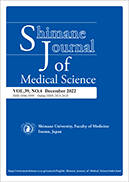Volume 39, Issue 4
Displaying 1-4 of 4 articles from this issue
- |<
- <
- 1
- >
- >|
Original article
-
Article type: Original article
2022 Volume 39 Issue 4 Pages 113-121
Published: 2022
Released on J-STAGE: July 28, 2023
Download PDF (1145K) Full view HTML -
Article type: Original article
2022 Volume 39 Issue 4 Pages 123-133
Published: 2022
Released on J-STAGE: July 28, 2023
Download PDF (1178K) Full view HTML -
Article type: Original article
2022 Volume 39 Issue 4 Pages 135-144
Published: 2022
Released on J-STAGE: July 28, 2023
Download PDF (1100K) Full view HTML -
Article type: Original article
2022 Volume 39 Issue 4 Pages 145-151
Published: 2022
Released on J-STAGE: July 28, 2023
Download PDF (729K) Full view HTML
- |<
- <
- 1
- >
- >|
